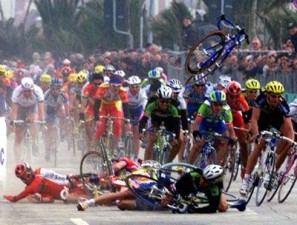 Right next door to my office a new niche recovery lounge has opened up (RechargeSportSF.com) attending to the most under-emphasized aspect of training: Recovery. There are several types of recovery: the acute phase (the minutes to hours after training or racing), the day to day/week to week recovery, and, as we saw in the TdF, the recovery from traumatic crashes and broken bodies offered up by the precariousness of the peloton. In this article, I will focus on the acute recovery from a crash or surgery and exercise-induced muscle damage. (Part 2 will explore different modalities and optimal timing).
Right next door to my office a new niche recovery lounge has opened up (RechargeSportSF.com) attending to the most under-emphasized aspect of training: Recovery. There are several types of recovery: the acute phase (the minutes to hours after training or racing), the day to day/week to week recovery, and, as we saw in the TdF, the recovery from traumatic crashes and broken bodies offered up by the precariousness of the peloton. In this article, I will focus on the acute recovery from a crash or surgery and exercise-induced muscle damage. (Part 2 will explore different modalities and optimal timing).
One of the biggest risks of our sport is crashing; the injuries ensuing -from broken collarbones to muscle crush injuries- are coupled with a long, arduous recovery process. It is well known (and most of us have experienced, at some point in our cycling careers) that the first week or two post injury is the hardest, with regard to regaining range of motion/movement and regaining muscle strength-firing patterns.
Injuries and consequent surgery are associated with hormonal and inflammatory stress responses that trigger a rapid muscle loss. In the first two weeks of disuse from injury, 150-400g of muscle mass can be lost from a single immobilized limb; coupled with metabolic changes that reduce the body’s ability to build muscle. Of additional concern is the functional strength loss from disuse; in general, this strength decline is approximately three times the rate of muscle mass loss. This functional strength loss is attributed to alterations in motor unit recruitment and the loss of skeletal calcium and magnesium stores (necessary for muscle contractions).
In the first week of immobilization, the general thought is the muscle mass loss is due to disuse. However, it is more an impairment in muscle-protein synthesis coupled with an increase in protein turnover that results in the muscle mass loss. As with most injuries, there comes a decrease in overall physical activity and a reduced energy intake. The reduced energy intake is a key point here: when trying to minimize muscle loss, inadequate protein intake accelerates muscle loss during disuse. By manipulating the diet to maintain adequate protein intake (~1.6 to 1.8g per kg body weight), the rate of muscle mass loss will slow, but will not be alleviated completely (due to a hormonal change that decreases the body’s ability to build muscle-aka anabolic resistance).
How to overcome Anabolic Resistance?
It is more than just “eat more protein”. Recent research has been investigating dosage as well as type of protein to garner the biggest anabolic response. What has been found is the anabolic response to a dose of protein increases in a dose-response manner. In healthy, young men, a 20-25g dose elicits maximal protein synthesis rates but in healthy older (>65y) men who have an anabolic resistance to dietary protein intake, this dose increases to 35-40g to maximize protein synthesis rates. Comparing healthy to injured young men, the dose response for the injured is akin to the dose needed in older men (35-40g). In the scheme of things, a frequent dose of 35-40g of protein can be difficult to consume (especially with reduced energy requirements). This is where the specific anabolic properties of protein come into play. The two critical properties are the digestion-absorption kinetics and the overall amino acid profile. For example, whey protein, which is more rapidly digested and absorbed than soy or casein has been shown to be more anabolic. However, when the soy or casein has been treated to have similar digestion and absorption rates to whey, they still do not exhibit the same anabolic responses. This is where the amino acid profile plays an important role: the greater the leucine content, the greater the stimulus for muscle protein synthesis.
Why Leucine? High stress exercise, injury, and post-exercise recovery all change amino acid and protein metabolism in skeletal muscle, with an increase in the metabolism of leucine. Specifically, the damage in the muscle tissue stimulates the breakdown of branched chain amino acids (coupled with total muscle cell breakdown) and in the recovery state, tissue levels of leucine must be increased in order to shut down the breakdown signals. The greater dietary intake of leucine, the faster the tissue levels rise which hastens the signaling of muscle synthesis. (Within the 35-40g of whole protein, the leucine content should be 2.5-3 grams.) Of particular interest is the recent research in the co-ingestion of protein and carbohydrate to elicit muscle synthesis. The current thought is that with carbohydrate, there is an increase in insulin release, which works with leucine to improve muscle cell synthesis. In states of anabolic resistance (injury, stress, age), co-ingestion of carbohydrate with protein slows the rate at which the protein is digested and absorbed and does not improve the rate of muscle synthesis. Thus, a 4:1 ratio of carbohydrate to protein will not improve muscle synthesis over dosages of 20-40g protein alone.
To further enhance muscle repair and to slow down muscle loss, fish oil (omega-3 fatty acids) supplementation has been making a mark. Specifically, long term supplementation (4g per day) has been shown to boost the anabolic sensitivity to amino acids. The omega-3 supplementation effect is not from dampening inflammation, but apparently sensitizing molecular pathways responsible for muscle cell synthesis.
What does all this mean? And how to put it all together?
If you are in a high stress state and/or are injured, with the potential of muscle mass loss (or lack of being able to put muscle on due to high stress and training loads), dosage of high quality (high leucine content) protein, timing of ingestion, and use of omega 3 fatty acids will help preserve and build muscle. Let’s use a hypothetical 160lb guy who has a major crash and ends up with a broken collarbone and a significant quadriceps crush injury. To reduce muscle mass loss and preserve strength during recovery, the ideal recommended daily protein intake is 116-130g of protein, ideally spread across four main meals (30-32g per meal with 2-3g of leucine). This amount counteracts the anabolic resistance caused by injury and with the timing, this equal spread keeps muscle synthesis rates elevated over a 24 hour period. In addition to the evenly spaced protein doses, a split supplementation of 4g omega-3 fatty acids (2g in the morning, 2g before bed) will maintain the upturn of muscle synthesis signaling.
Injury, crashes, and high stress are unfortunately unavoidable in our sport, but knowing how to manipulate the body’s responses to minimize muscle and strength loss will shorten the recovery time and get you back on your bike!
(Part 2: Modalities: compression, cooling, neuromuscular electrical stim, massage, and timing. Note- if there are other modalities you are interested in, drop a note and I’ll cover it!)
 Stacy Sims, MSc, PhD, served as an exercise physiologist and nutrition scientist at Stanford University specializing in recovery and nutritional adaptations for health, body composition, and maximizing performance. During the past decade she has worked as an environmental physiologist and nutrition specialist for top professional cyclists and triathletes, ultra-endurance athletes, the Garmin/Slipstream Pro Cycling Team, USA Cycling Olympic Team (BMX and women’s track cycling), Team Tibco, Flying Lizard Motorsports, and Team Leopard-Trek, among others. She competes as a Cat 1 road cyclist and elite XTerra triathlete and is co-founder of OSMO Nutrition.
Stacy Sims, MSc, PhD, served as an exercise physiologist and nutrition scientist at Stanford University specializing in recovery and nutritional adaptations for health, body composition, and maximizing performance. During the past decade she has worked as an environmental physiologist and nutrition specialist for top professional cyclists and triathletes, ultra-endurance athletes, the Garmin/Slipstream Pro Cycling Team, USA Cycling Olympic Team (BMX and women’s track cycling), Team Tibco, Flying Lizard Motorsports, and Team Leopard-Trek, among others. She competes as a Cat 1 road cyclist and elite XTerra triathlete and is co-founder of OSMO Nutrition.
Suggested Reading:
- Wall BT, Morton JP, and van Loon, LJC. Strategies to maintain skeletal muscle mass in the injured athlete: Nutritional considerations and exercise mimetics. Eur J Sport Sciences; Jul 2014.
- Gorissen S, Burd N, Hm H, Gijsen A et al. Carbohydrate co-ingestion delays dietary protein digestion and absorption but does not modulate postprandial muscle protein accretion. J Clinical Endo Metabol, 2014; 99(6): 2250-2258.
- Hamer H., Wall B., Kiskini A, de Lange A., et al. Carbohydrate co-ingestion with protein does not further augment post-prandial muscle protein accretion in older men. Nutr Metabol, 2013; 10(1): 10-15.
- Sousa M, Teixeira VH., and Soares J. Dietary strategies to recover from exercise-induced muscle damage. Int J Food Sci Nutr, 2014; 65(2):151-163.